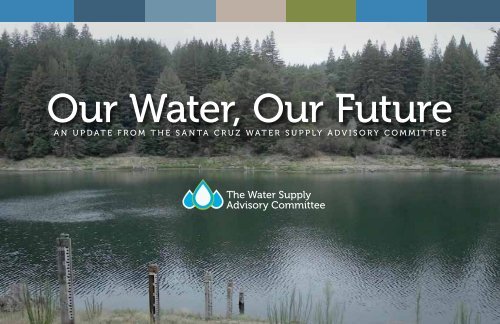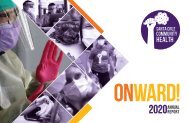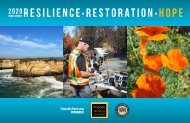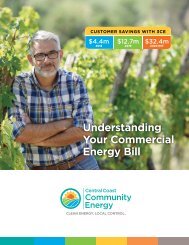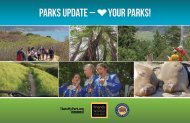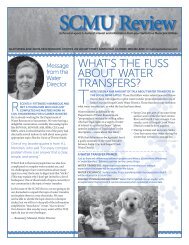WSAC Annual Report 2015
You also want an ePaper? Increase the reach of your titles
YUMPU automatically turns print PDFs into web optimized ePapers that Google loves.
Our Water, Our Future<br />
AN UPDATE FROM THE SANTA CRUZ WATER SUPPLY ADVISORY COMMITTEE
Our Water, Our Future<br />
An update from the Santa Cruz Water Supply Advisory Committee (<strong>WSAC</strong>)<br />
The Santa Cruz community has long faced challenges with the reliability of its<br />
water supply. Many solutions have been looked at over the past four decades.<br />
In October 2013, the City Council decided to take a different approach to<br />
solving our water woes than we had in the past. A committee of residents<br />
representing diverse perspectives was appointed to take an exhaustive look<br />
at our water issues and ways we can address them. Thus, the Water Supply<br />
Advisory Committee was born.<br />
The <strong>WSAC</strong> operates independently and employs a technical support team and<br />
an Independent Review Panel. The committee is funded by the City of Santa<br />
Cruz and assisted by Water Department staff. The <strong>WSAC</strong> has its own charter,<br />
is fully transparent and operates under California’s open public meeting laws.<br />
There are 14 committee members, representing local interests including the<br />
environment, business, education and the City’s Water Commission.<br />
<strong>WSAC</strong> Members<br />
• David Baskin, Chair of the<br />
Water Commission<br />
• Peter Beckman, Think Local First<br />
• Doug Engfer, At-Large<br />
Community Member<br />
• Sue Holt, Unincorporated Areas<br />
Served by the Santa Cruz Water Dept.<br />
• Dana Jacobson, City of Santa Cruz<br />
At-Large<br />
• Charlie Keutmann, City of Santa Cruz<br />
At-Large<br />
• Rick Longinotti, Desal Alternatives<br />
• Sarah Mansergh, Surfrider Foundation<br />
• Mark Mesiti-Miller, Santa Cruz Area<br />
Chamber of Commerce<br />
• Greg Pepping, Coastal<br />
Watershed Council<br />
• Mike Rotkin, Sustainable<br />
Water Coalition<br />
• Sid Slatter, Santa Cruz County<br />
Business Council<br />
• Erica Stanojevic, Sierra Club<br />
• David Stearns, Water Commissioner<br />
SantaCruzWaterSupply.com
FAQs<br />
How are community members who are not<br />
water experts qualified to develop a plan for<br />
our water supply?<br />
<strong>WSAC</strong> members undertook a robust education<br />
about our water system and have a thorough<br />
understanding of the challenges it faces. The <strong>WSAC</strong><br />
also has the support of a diverse professional technical<br />
team with expertise in engineering, hydrogeology,<br />
demand forecasting, supply modeling and<br />
demand management.<br />
What power does the <strong>WSAC</strong> have and what will<br />
they produce?<br />
<strong>WSAC</strong> members were appointed by the City Council<br />
to produce a set of recommendations for solving the<br />
City’s water supply challenges. Their recommendations<br />
will be presented to the City Council this fall.<br />
Can’t more conservation solve the problem?<br />
In all scenarios, conservation will continue to play<br />
an important role in helping us manage our water<br />
resources. However, the <strong>WSAC</strong> has learned that<br />
conservation alone will not fill the supply gap in dry<br />
and critically dry years.<br />
What are “fish flows” and why are<br />
they significant?<br />
The City’s key water sources are the north coast<br />
streams of Laguna, Majors and Liddell Springs, and<br />
the San Lorenzo River. Threatened and endangered<br />
fish species such as steelhead trout and coho salmon<br />
depend upon these waterways. When the City diverts<br />
water from these streams for our water supply, water<br />
for these species is reduced, which may cause harm<br />
to them. The City is working with state and federal<br />
agencies to negotiate enough water – known as<br />
“flows” – for fish. However, more water for fish means<br />
less water available for people.<br />
How can I get involved?<br />
Come to the Water Supply Showcase on September 9<br />
(details on back) and talk with <strong>WSAC</strong> members about<br />
what they’ve learned and how they think we should<br />
address our supply shortages.<br />
Attend the Water Supply Advisory Committee meeting<br />
on September 10 and 11. Talk about the proposed<br />
ideas with your friends and family and share your<br />
thoughts with the City Council.
Santa Cruz<br />
Water Supply<br />
Convention<br />
The Santa Cruz Water Supply Convention<br />
– held Oct. 16, 2014 – provided community<br />
members and city staff a “science fair-style”<br />
opportunity to present their ideas and<br />
strategies to increase our water supply.<br />
• More than 80 ideas were submitted.<br />
• 50 proposals were presented.<br />
• Presenters had the opportunity to share<br />
their ideas, talk with the public<br />
and answer questions.<br />
Here are examples of the ideas presented:<br />
• Capture humidity in the air and turn it into<br />
drinking water<br />
• Reduce demand by changing landscapes<br />
• Collect and reuse rainwater and greywater<br />
• Design water rates to promote conservation<br />
• Change building and plumbing codes to<br />
improve water efficiency<br />
• Purify and reuse wastewater<br />
• Pursue new technologies for desalinating<br />
sea water<br />
Community Engagement Timeline<br />
Beginning April 2014, the <strong>WSAC</strong> has held regular meetings monthly, all open to the public.<br />
Monthly public Santa Cruz Water Modeling and<br />
2014 <strong>2015</strong><br />
REGULAR<br />
MEETINGS<br />
meetings begin<br />
Apr 30<br />
APR 30, MAY 1-2,<br />
MAY 29-30<br />
JUN 26-27<br />
JUL 31, AUG 1<br />
AUG 27, 29<br />
SEP 24, 26<br />
Supply Convention<br />
Oct 16<br />
forecasting working<br />
group meetings<br />
Nov 12, Dec 3, 10<br />
OCT 23-24 NOV 19, 21<br />
DEC 17, 19<br />
Modeling and<br />
forecasting working<br />
group meetings<br />
Jan 7, 14, 21<br />
Study Session:<br />
Beyond Building<br />
Codes, Feb 11<br />
Study Session:<br />
Endangered<br />
Species Act<br />
Update<br />
Mar 18<br />
FEB 12-13 MAR 18, 20
Where Does Our Water Come From and Who Uses It?<br />
Supply<br />
■ San Lorenzo River..................46%<br />
■ North Coast Streams.............25%<br />
■ Loch Lomond..........................22%<br />
■ Beltz Wells................................... 4%<br />
■ Tait Wells..................................... 3%<br />
Demand<br />
■ Single Family Residential....41%<br />
■ Multiple Residential..............23%<br />
■ Business.....................................19%<br />
■ UCSC/Industrial........................ 7%<br />
■ Irrigation..................................... 4%<br />
■ Golf Course Irrigation............. 3%<br />
■ Municipal.................................... 2%<br />
■ Coast Irrigation......................... 1%<br />
Preliminary estimates are that the gap between our supply and demand is 1.1 billion gallons per year. We need a portfolio of actions<br />
we can take that will give us access to 1.1 billion more gallons of water to get us through dry years and to support fish habitat.<br />
Study Session:<br />
Climate Change<br />
Apr 8<br />
Study Session:<br />
Water Transfers/<br />
Aquifer Recharge<br />
Apr 22<br />
Study Session:<br />
Surf City Saves<br />
May 21<br />
Study Session:<br />
Water Reuse<br />
Jun 17<br />
Joint <strong>WSAC</strong>/<br />
City Council<br />
Meeting<br />
Jun 23<br />
Study Session:<br />
Groundwater<br />
Aug 26<br />
Water Supply<br />
Showcase<br />
Sep 9<br />
Recommendations<br />
to City Council<br />
Oct<br />
APR 30, MAY 1 JUNE 11-12 JUL 23, 24 AUG 13, 14<br />
SEP 10, 11
Key Challenges<br />
The <strong>WSAC</strong> has identified three fundamental challenges to Santa Cruz’s water supply.<br />
Lack of Storage<br />
95% of Santa Cruz’s water supply<br />
comes from local rivers and streams.<br />
When water levels are low, such as in<br />
drought years, we depend on stored<br />
water. Loch Lomond Reservoir, our only<br />
storage for untreated water, holds 2.8<br />
billion gallons of water – less than one<br />
year’s worth of water. Lack of adequate<br />
storage makes us very vulnerable to<br />
shortages in dry years.<br />
Climate Change<br />
It is likely that climate change will have<br />
some impact on the Central Coast in<br />
the coming years. Potential impacts<br />
might include less frequent, but more<br />
severe, storms or more frequent and<br />
more extended periods of drought.<br />
Climate change must be factored into<br />
supply planning.<br />
Enough Water for Fish<br />
Water taken from rivers and streams<br />
threatens the survival of native<br />
fish species like coho salmon and<br />
steelhead trout. Our community is<br />
deeply committed to environmental<br />
sustainability, even if it means<br />
going beyond the minimum legal<br />
requirements to reduce our impacts.
— WHAT WE’VE LEARNED —<br />
Fish flows are a major issue. Providing<br />
enough water for threatened fish species has<br />
a significant impact on our available supply.<br />
Climate change has the<br />
potential to seriously exacerbate<br />
our current challenges.<br />
Though there is excess water available during<br />
most winter storms, finding a place to store it<br />
isn’t as straightforward as it may seem.<br />
Some ideas that seem simple and obvious<br />
have major flaws technically, geologically,<br />
legally or financially.<br />
Example: storing water in abandoned quarries.<br />
Some ideas that do work technically,<br />
geologically, legally or financially raise<br />
community concerns for other reasons.<br />
Example: recycled water.
You’re Invited:<br />
Water Supply Showcase<br />
Following nearly 18 months of exploration and development,<br />
the <strong>WSAC</strong> has identified a portfolio of leading water supply<br />
recommendations. Come learn about the proposed solutions,<br />
talk with <strong>WSAC</strong> members, get your questions answered and<br />
tell us what you think.<br />
Wednesday, September 9, 5-7:30 p.m.<br />
Louden Nelson Auditorium, 301 Center St., Santa Cruz<br />
Water Department Conservation Office<br />
212 Locust Street, Suite B<br />
Santa Cruz, CA 95060<br />
PRSRT STD<br />
US POSTAGE<br />
PAID<br />
SANTA CRUZ, CA<br />
PERMIT NO. 11


